Bruno Lage Tactics At Botafogo
Botafogo are running away with this year’s Brazilian Série A.
This was almost unthinkable at the start of the year, but at the time of writing, Botafogo have just won the symbolic Primeiro Turno, the first half of the league, sitting 13 points clear at the top of the table.
There is still a long way to go, but Fogo show no signs of slowing down.
Behind them?
Well, aside from Palmeiras, Flamengo and Grêmio are not putting up much of a fight.
After failing to qualify for the Carioca’s knockout rounds, falling short of third-tier side Volta Redonda, Botafogo’s season did not look promising.
Surprisingly, however, Fogo began the Série A with a flying start.
After finding exciting consistency, their manager, Luis Castro, left the club to manage the former Man United and Real Madrid legend Cristiano Ronaldo in Saudi Arabia.
Doubts emerged, but they were quickly put to bed after the rapid appointment of former Premier League manager Bruno Lage.
The transition was seamless, which points to John Textor’s club management.
The American owner purchased the club two years ago when they were in the Série B.
Textor has famously fallen in love with the club, symbolised by his presence at the away end of a cold Copa Sudamericana night.
Additionally, the structure implemented by the new ownership has introduced stability rarely found in Brazil.
Despite the heavy investment, the club has no big names.
All signings have been punctual, pointing to a methodical approach to squad building.
The club has a clear identity, aligning processes from recruitment to the style of play.
The managerial appointments substantiate this.
Both Luis Castro and Bruno Lage come from the Portuguese school of football, with similar methodologies and ideas.
The Tactical Periodisation, famously adopted by José Mourinho, provides a peak into the behind-the-scenes.
Tactically, the two managers are also very similar, and the implementation has undoubtedly been expedited by the consistent positional profiles in recruitment.
This project has taken the club from the Série B to the very elite of the Série A, and there is a lot to appreciate about the work being done in Rio de Janeiro.
This tactical analysis will focus on Bruno Lage tactics behind Botafogo’s success, with the objective of identifying how the Glorioso are dominating the Série A.
In other words, this analysis will take a detailed look at the vital tactical pillars behind Botafogo’s season, first implemented by Luis Castro and now managed under Bruno Lage.
Botafogo Out of possession
Surprisingly, the prospective champions average 45.9% possession, currently the eighth-lowest in the league.
While this indeed points to their work in possession, it also emphasises the importance of their defensive system.
Interestingly, when winning games, Fogo only average 39.75% possession.
This further illustrates the significance and perhaps confidence in their work out of possession.
On the contrary, as seen by the likes of Man City and Barcelona, league champions tend to rely on attacking dominance to stay at the top throughout 38 matches.
For instance, City averaged 61.1% possession in winning situations in last season’s Premier League.
Furthermore, their 12.74 PPDA and 5.2 Challenge Intensity are the second-highest and fifth-lowest in the league, respectively.
These are especially curious, given the Glorioso have the best attack in the league.
Rather than falling to extremes, the best term to describe Fogo’s tactical approach is balance.
They are incredibly effective in all four phases of the game, and whatever the game asks for, they are able to provide it.
Lage’s men usually start with a high block, looking to disrupt the opposition’s construction and potentially create chances from it.
While in possession, they use a hybrid 4-2-3-1/4-3-3 organisation; their defensive block is a 4-2-3-1/4-4-2 hybrid.
The more attacking midfielder of the three will be the one to join the centre-forward in the first line of pressure.
This advanced player is usually Eduardo, although it can also be Tchê Tchê at times.
Against Santos, Tchê Tchê was the attacking midfielder joining the league’s top goalscorer, Tiquinho Soares, upfront.
Marlon Freitas and Danilo were the two central midfielders flanked by Luis Henrique and Junior Santos.
The wide midfielders start in the half-spaces, compacting the defensive block.
Their trigger is the opposition full-back, and when the opposition orientates their build-up to one side and plays it to the full-back, this wide midfielder will jump to pressure him.
The respective forward will press the centre-back, while the far forward tucks into a compact block, sometimes picking up a deep-lying midfielder.
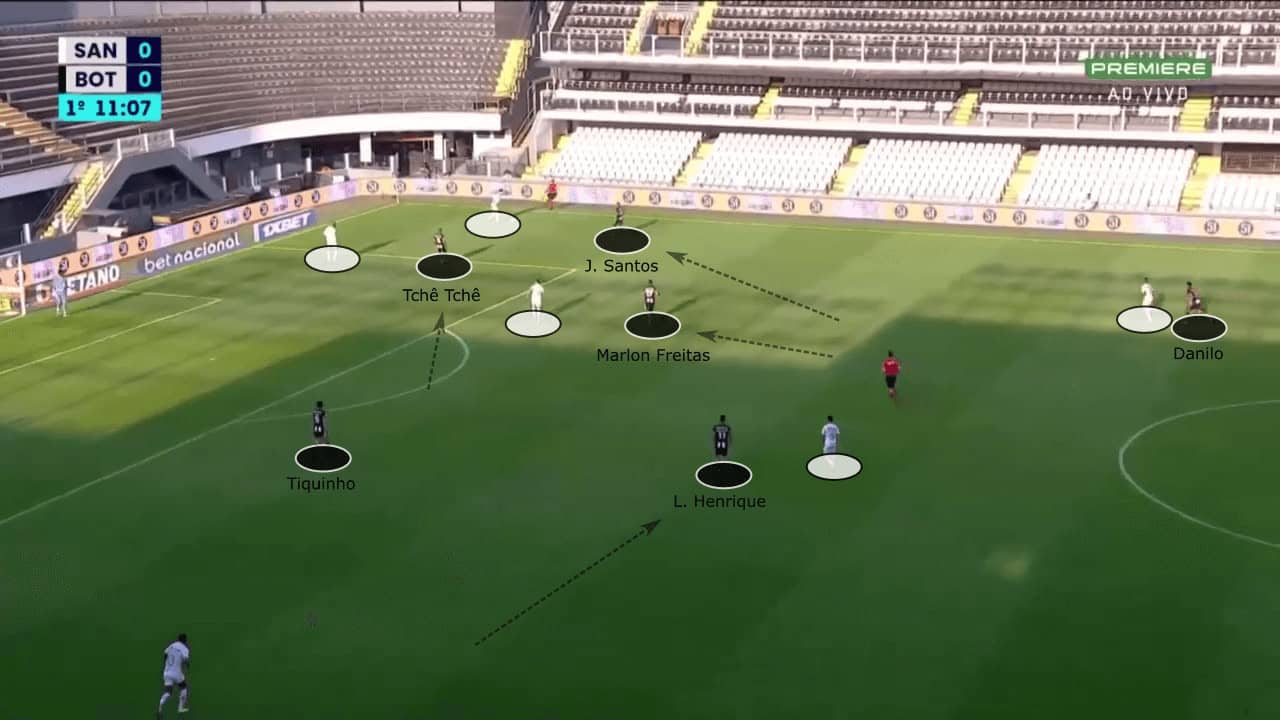
The two midfielders look to mark the opposition’s options inside.
Danilo sits deeper, marking Santos’ advanced midfielder in this case, while Marlon Freitas picks up the deepest midfielder.
The far wide midfielder, Luis Henrique, looks to tuck in to compact the block and possibly pick up a midfielder.
Obviously, there is a lot of variability, particularly as a response to the opposition’s shape.
However, the 4-4-2 with these triggers and patterns is the consistent basis from which they press.
Tactics aside, Botafogo have incredible discipline and intensity in their behaviour out of possession.
Whether in a mid or a high block, they are able to maintain a compact structure while denying immediate options to the ball carrier.
Additionally, they are an extremely physical side.
Their tactical discipline allows them to put the opposition under immense pressure, overwhelming and disrupting their construction.
However, they are also capable of challenging duels and 50/50 scenarios.
Their 60% success rate in defensive duels and 49.1% in aerial duels are the second and third highest in the league, respectively.
While their high block certainly helps their performance in the game, they are also very comfortable dropping into a mid-to-low block.
As mentioned, they are very likely to do this in winning situations.
Generally, however, their mentality is if the game requires it, they are prepared to provide it.
In this mid-to-low block, their organisation slides from a more stable 4-4-2 to a more hybrid 4-4-2/4-2-3-1.
The advanced midfielder’s positioning is slightly deeper, looking to populate the midfield and deny progression in the central areas.
However, rather than strictly marking the opposition’s defensive midfielder, this player will look instead to block the passing lane by splitting him and the ball carrier.
Behind him, the midfield line of four begins hugely compact.
The two wide midfielders will initially tuck in alongside the middle two and congest the central areas.
The compact structure is the primary goal, but they are also responsible for picking up any immediate options for the ball carrier.
Ideally, the opposition’s access and progression through the central lanes should be minimal, being forced to go wide.
Again, the opposition’s full-back receiving the ball triggers the wide midfielder’s press, and the block compactly shifts across in a zonal manner.
Tchê Tchê, below, is in a great position to deny access to Internacional’s two midfielders.
Lucas Fernandes, the advanced midfielder in this game, also restricts access to the deepest midfielder while pressing the centre-back.
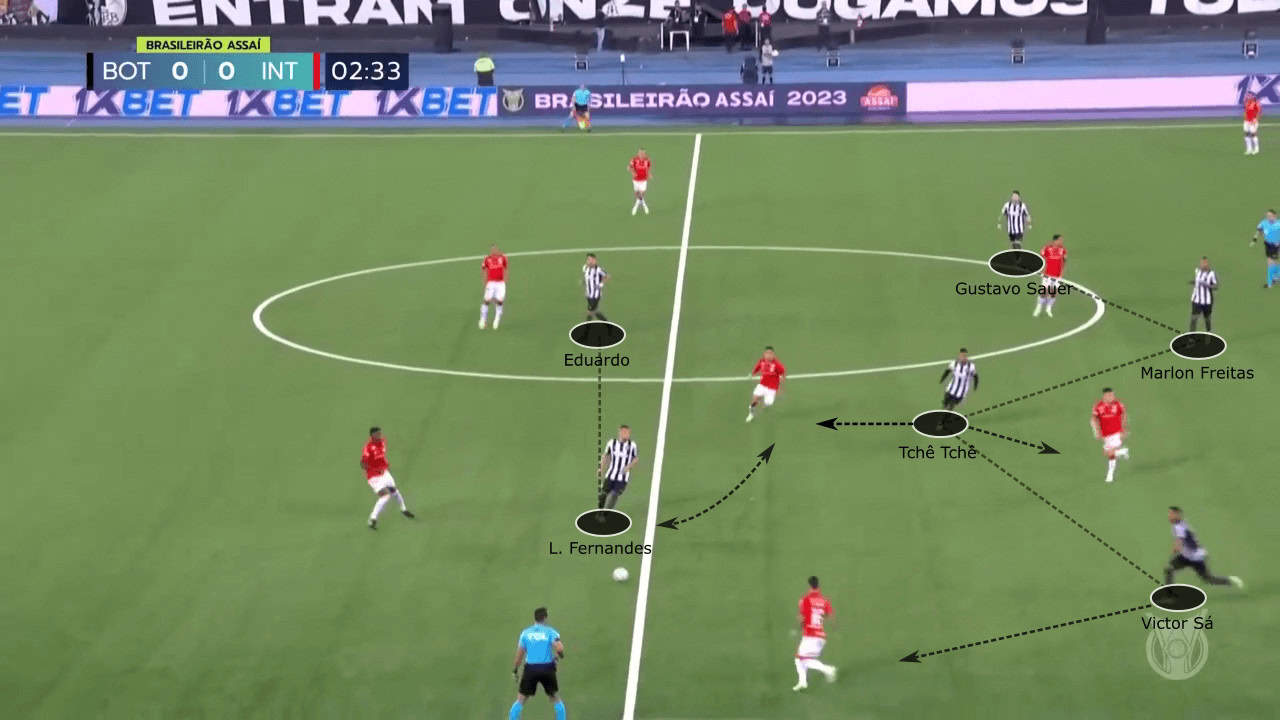
There is variability in order to cope with the variance in opposition structure, but the block’s behaviour is generally consistent.
It is certainly effective, highlighted by their 11 goals conceded, five fewer goals than the second-best defence.
Lastly, against Santos again, their defensive balance limits the opposition’s progression through the central and wide areas.
As explored, the central lanes are initially very well protected.
If the opponent goes wide, they can shift accordingly and immediately apply pressure.
While this is done, the central lanes are still very safe, as shown below.
After playing it to the right-back, Santos quickly access the nearest defensive midfielder.
Luis Henrique, the wide midfielder, jumps to make the initial press, and they shift accordingly.
As the ball is played back inside, the two forwards immediately crash into him while Marlon Freitas marks him from behind.
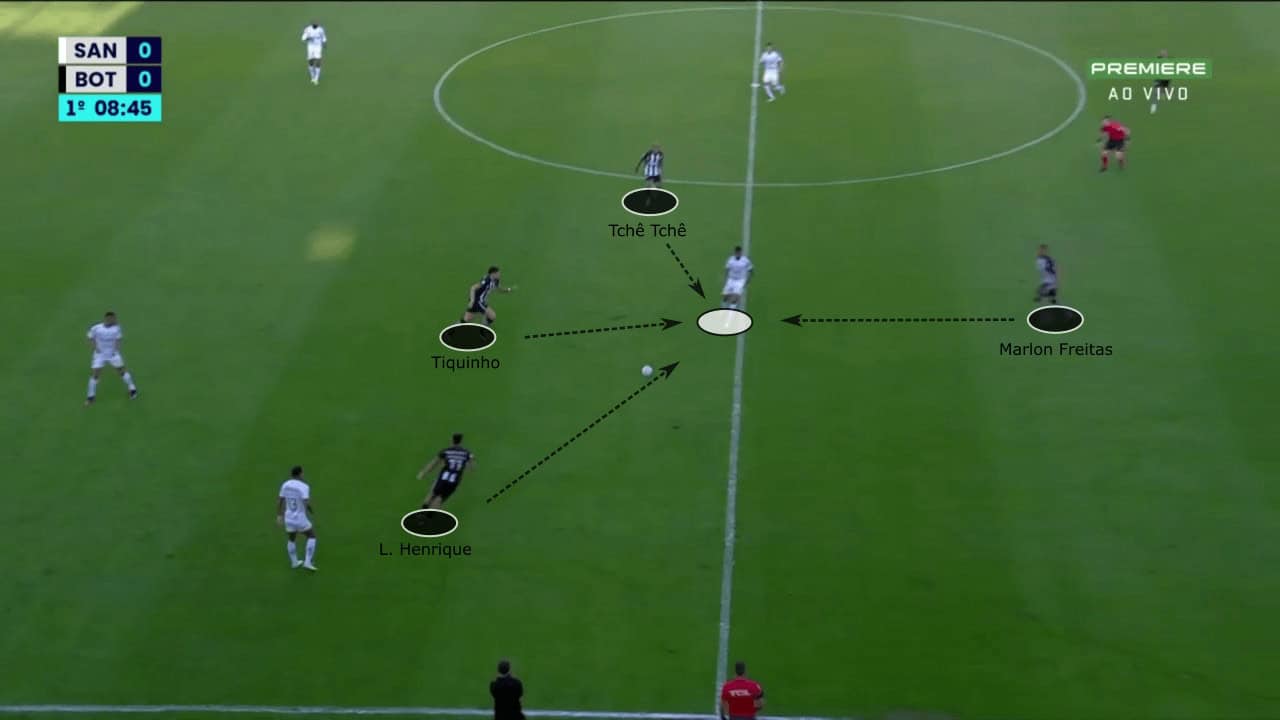
While the initial defensive organisation is very pleasing to observe, the functionality of the defensive system in response to the development of the opposition’s possession is especially impressive.
It consistently defends whichever zone the opposition may look to progress, and however it may develop, their discipline and compactness allow them to quickly adapt and deny further progression.
Tactically, their defensive system is exceptionally sound.
Further, their physicality, relating to both fitness and strength, takes their work out of possession to the next level.
This is backed up by the statistics, both in the success rate of varying types of duels and in the overall goals conceded.
Botafogo In possession
While their strength may very well be in the defensive phase of the game, their work in possession is just as effective.
Statistically, their metrics do not point to any sort of dominance or long periods spent with the ball.
Moreover, 12.14% of their passes are long, so they are not afraid to be vertical either.
Nonetheless, they have the best attack in the league.
Consistently, in possession, whatever the game requires, they are able to provide it.
The level of the opposition may indicate their verticality with the ball.
However, the moments of the game may also indicate the development of their possession.
If control is required, they can be more passive.
Similarly, if verticality is necessary against a very aggressive side, they are also able to provide it.
Many influences dictate a game of football, and Botafogo’s ability to have a two-way interaction with the game rather than trying to impose a specific style of possession is very admirable.
Consequently, this analysis will focus more on the structural developments and tendencies rather than the tempo or verticality of their possession.
This structure begins from a 4-2-3-1/4-3-3 hybrid organisation.
In the midfield, one deep-lying midfielder primarily works as a single pivot, a more box-to-box midfielder, and a more advanced midfielder.
Marlon Freitas is usually the deepest, with Danilo as a backup.
Tchê Tchê performs as the box-to-box midfielder with a highly versatile profile, and Eduardo is generally the advanced midfielder.
The structure tends to be quite asymmetrical, especially when the centre-forward, Tiquinho, comes into play.
The Série A top goal scorer has a very free-roaming role, capable of dropping into the midfield to provide more vertical passing lanes or combine with the midfielders.
Usually, he focuses more on the left side of the pitch, meaning Eduardo, the advanced midfielder, occupies more of the right side.
Tchê Tchê stays more on the left, while Marlon Freitas is more on the right.
However, this is a very loose organisation, and the shape has excellent structural fluidity.
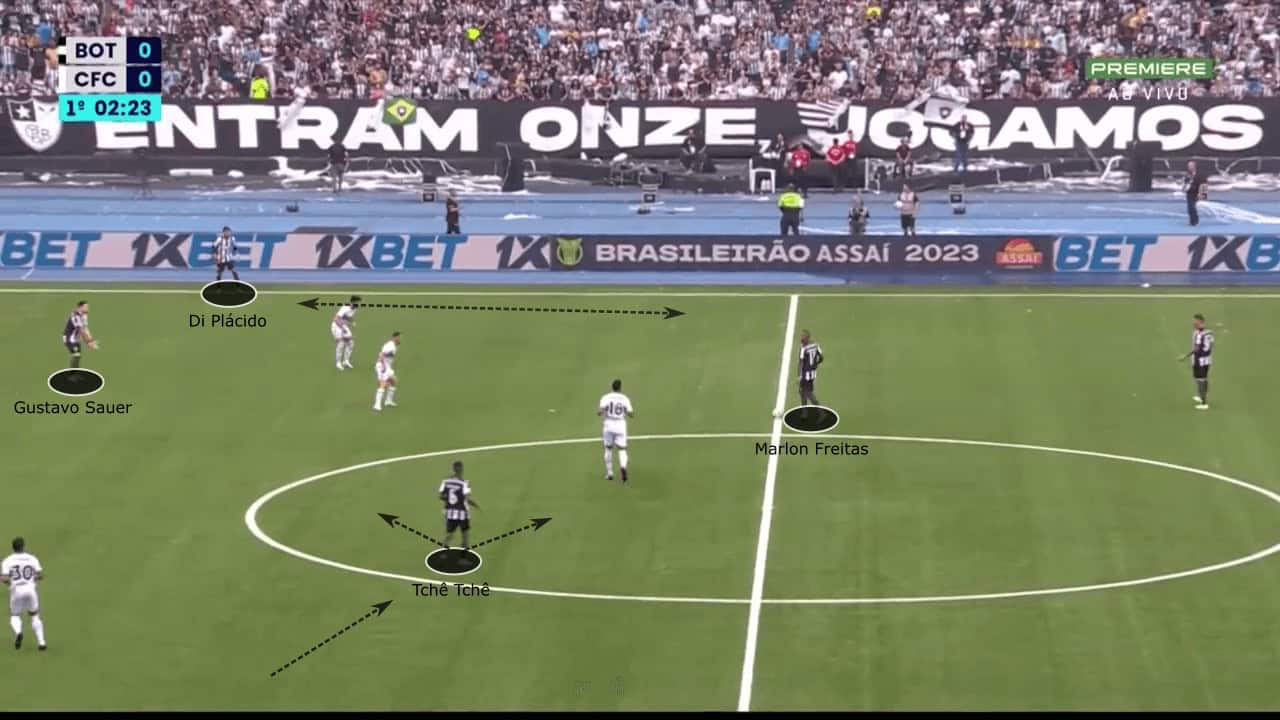
The full-backs are capable of providing support in deeper areas as well as pushing up higher.
The wide midfielders work in response, trying not to occupy the same space as the full-back, as seen by Gustavo Sauer’s movement inside in the image above.
With the rough distribution of the players throughout the pitch now clear, we can start to look at how this develops.
The midfield remains typically very compact.
Their asymmetrical structure can be identified below, but how close they are to each other is notable.
Additionally, the full-backs’ relative height relative to the ball can be determined.
Lastly, Sauer once again moves inside while the right-back remains wide.
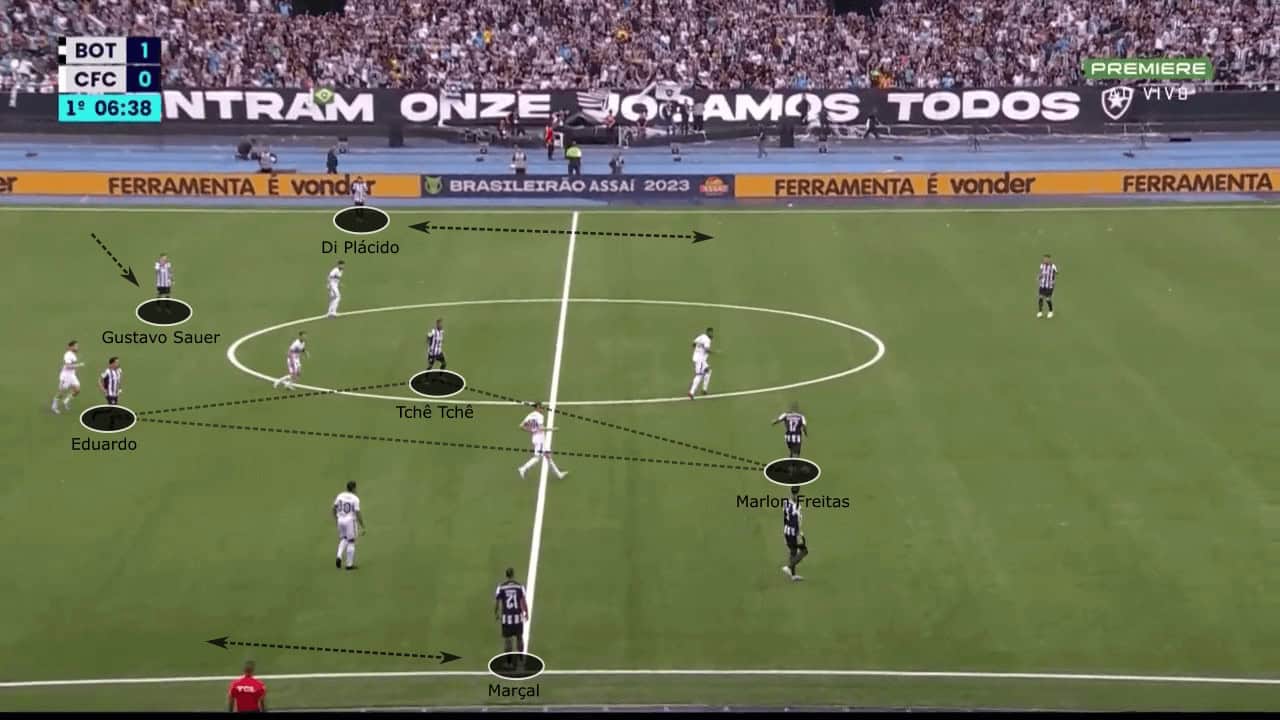
This compactness allows for dynamic combinations in the central areas, and the far midfielders, in the image above Tchê Tchê and Sauer, provide quick access to the other side of the pitch.
They are undoubtedly able to more passive and assert control, usually by circulating the ball between Marlon and the back four.
However, they can also look for vertical options more aggressively, generally looking to find the advanced midfielders and the centre-forward higher up the pitch.
Their compact nature allows for quick combinations and retention once the lines are penetrated, and their full-backs supporting positioning out wide also allows for an option away from pressure.
While their rough organisation was noted earlier, it is also important to mention they can be very fluid in some instances.
Eduardo may sometimes join Tiquinho on the same side, or Tchê Tchê may advance into a further position.
There are numerous possibilities, and they can communicate very well to maintain organisation.
Now focusing on the wide areas, we can observe a few more structural tendencies.
Eduardo has shifted all the way wide, and Victor Sá moves inside in response.
Marçal also stays deeper to provide a recycling option.
Tchê Tchê and Tiquinho stay further inside, but they are still looking to provide passing options.
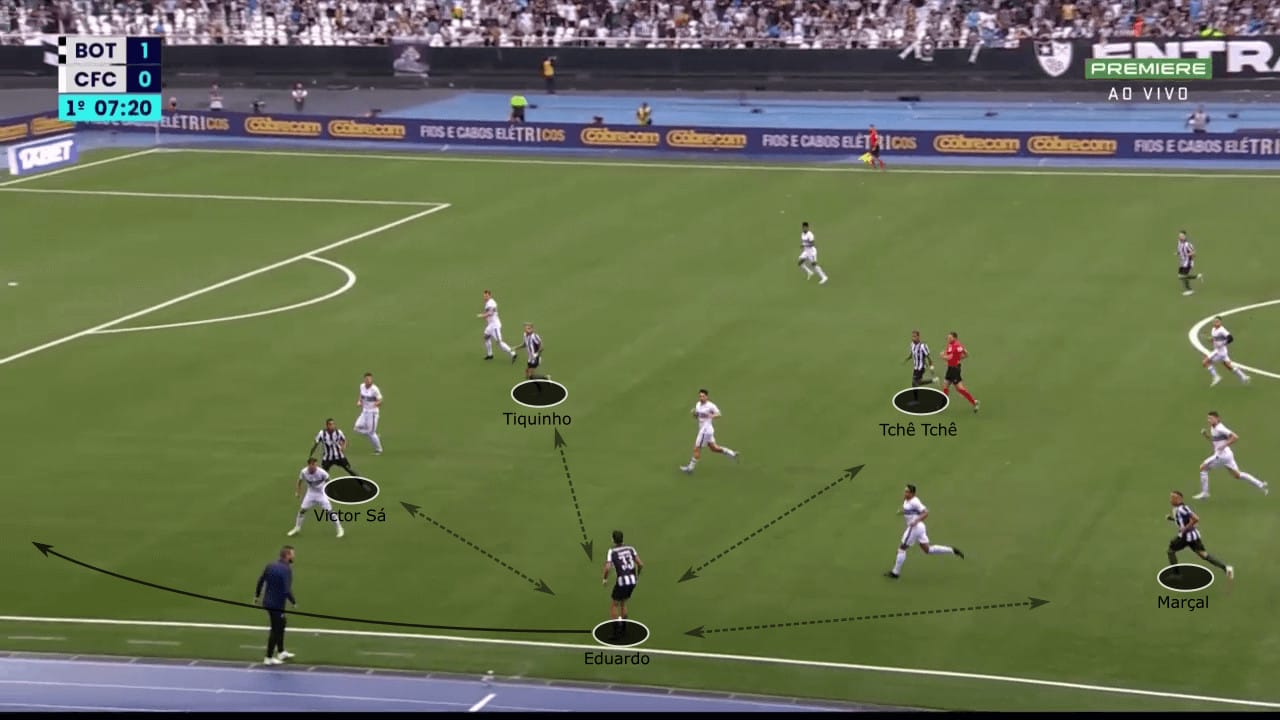
In another instance, Leonel Di Plácido, the right-back, now stays wide so Tchê Tchê, the nearest midfielder, supports from behind.
Marlon Freitas also provides support, and Lucas Fernandes, the far midfielder, tucks in to provide a way out.
Finally, Sauer moves inside to give a diagonal option to Di Plácido and Tchê Tchê.

Botafogo have an initial reference in possession, but its developments can be very fluid and non-linear.
Consequently, their communication becomes critical in rotating spaces and maintaining an efficient organisation.
Their structure does have a very compact nature, mainly because of the midfield’s movements.
Nonetheless, it provides a great starting point for their work with the ball.
Botafogo Transitions
Their attacking and defensive transitions function very well with their work in and out of possession.
As explored, their attacking structure has a relatively compact nature, and this undoubtedly helps their defensive transitions.
As seen below, the three midfielders immediately cover once the ball is lost in the final third.
Hugo, the far full-back, also moves in to provide a defensive diagonal.
They are able to provide immediate pressure to the ball carrier while also covering access into the space behind.
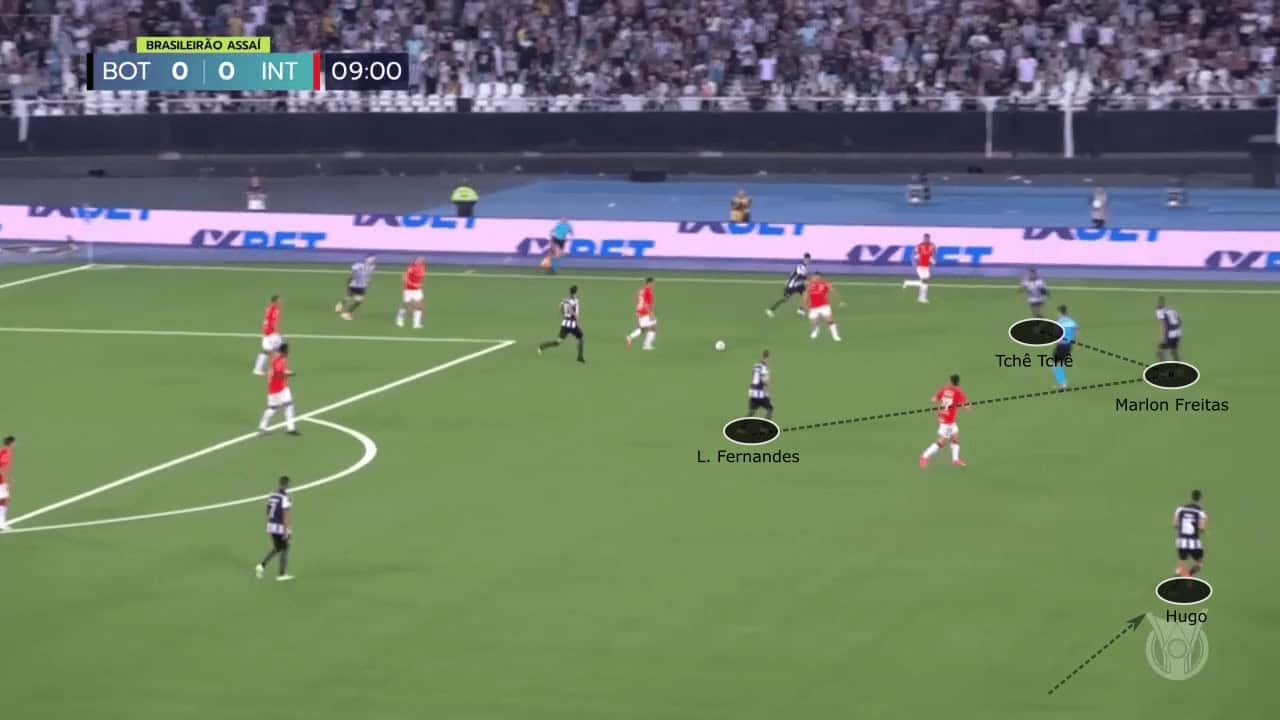
There is a seamless transition because of consistent principles.
Compactness is the clearer one, but the importance of physicality and intensity in their tactical behaviour is another.
The overlapping principles from phase to phase are crucial in making their transitions so effective, especially in attack.
In attacking transitions, Botafogo look to quickly access the wide areas and launch their counterattacks.
In the example below, Tiquinho recovers the ball and immediately plays it wide to Luis Henrique.
To emphasise the focus on wide areas, Tiquinho makes an overlapping run to help Luis and allow the midfielders to get up in dangerous positions.
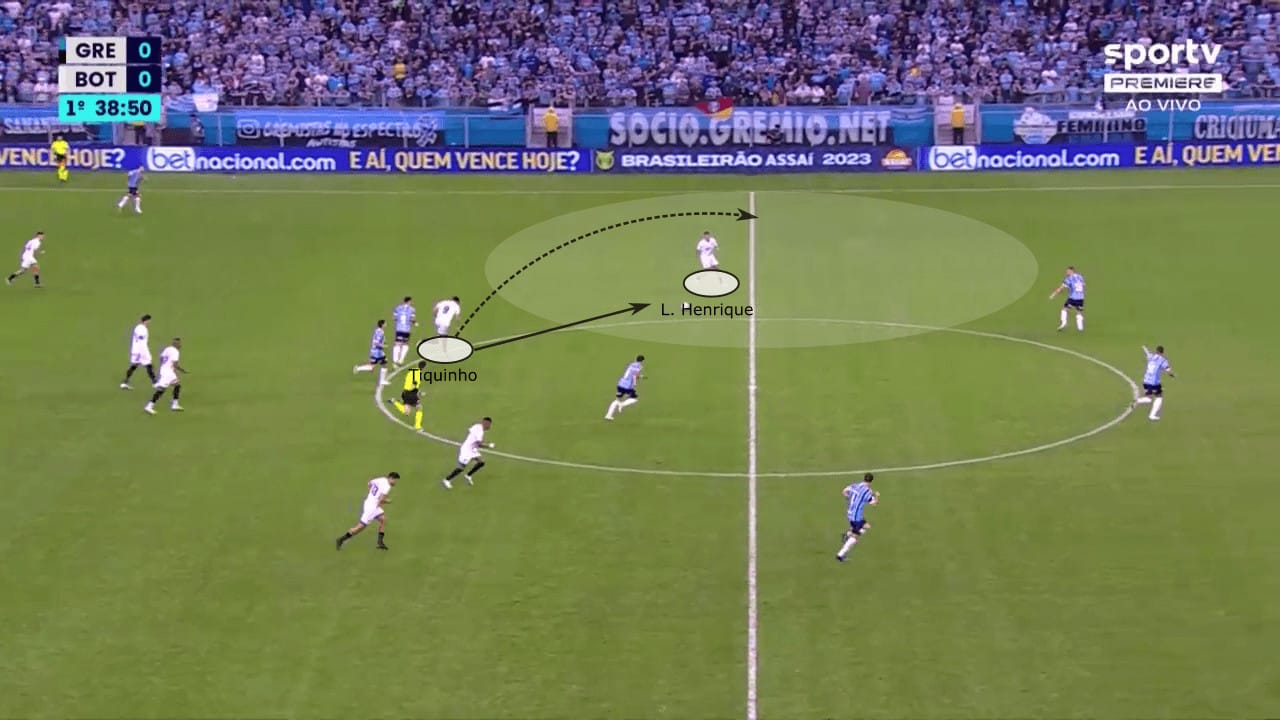
Now against Internacional, their vertical transition begins with a long ball after the ball is recovered at the back.
With a particular centre-forward profile, Tiquinho or his replacement Janderson are very good at winning the first balls.
In the instance below, Eduardo immediately makes himself available to get the second ball.
After Janderson headers it down, Eduardo beautifully volleys it wide for Luis Henrique to advance into space.
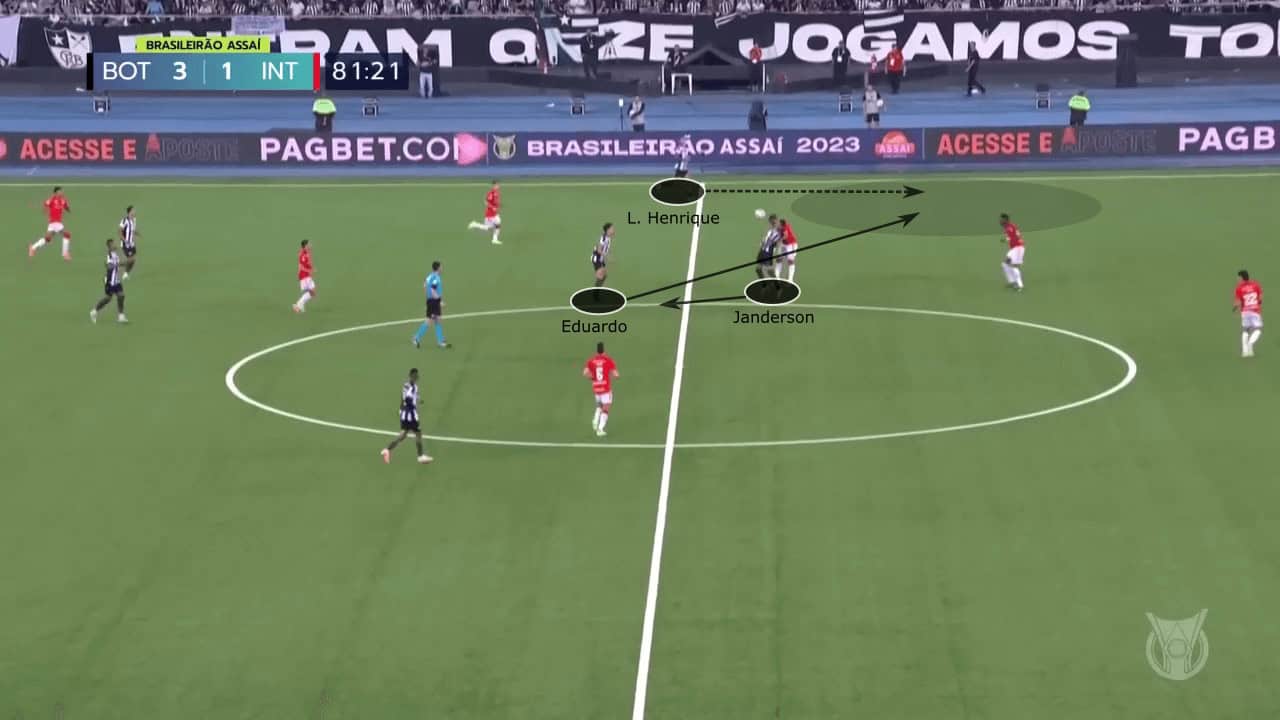
Conclusion
Botafogo seem to be the clear favourite for this year’s Brazilian Série A, and deservedly so.
John Textor’s project has proven remarkably aligned in all areas, and despite turbulences, Botafogo have found an admirable consistency.
They look solid heading into the second half of the season, and it seems like whatever is thrown at them, tactically, they are able to respond!

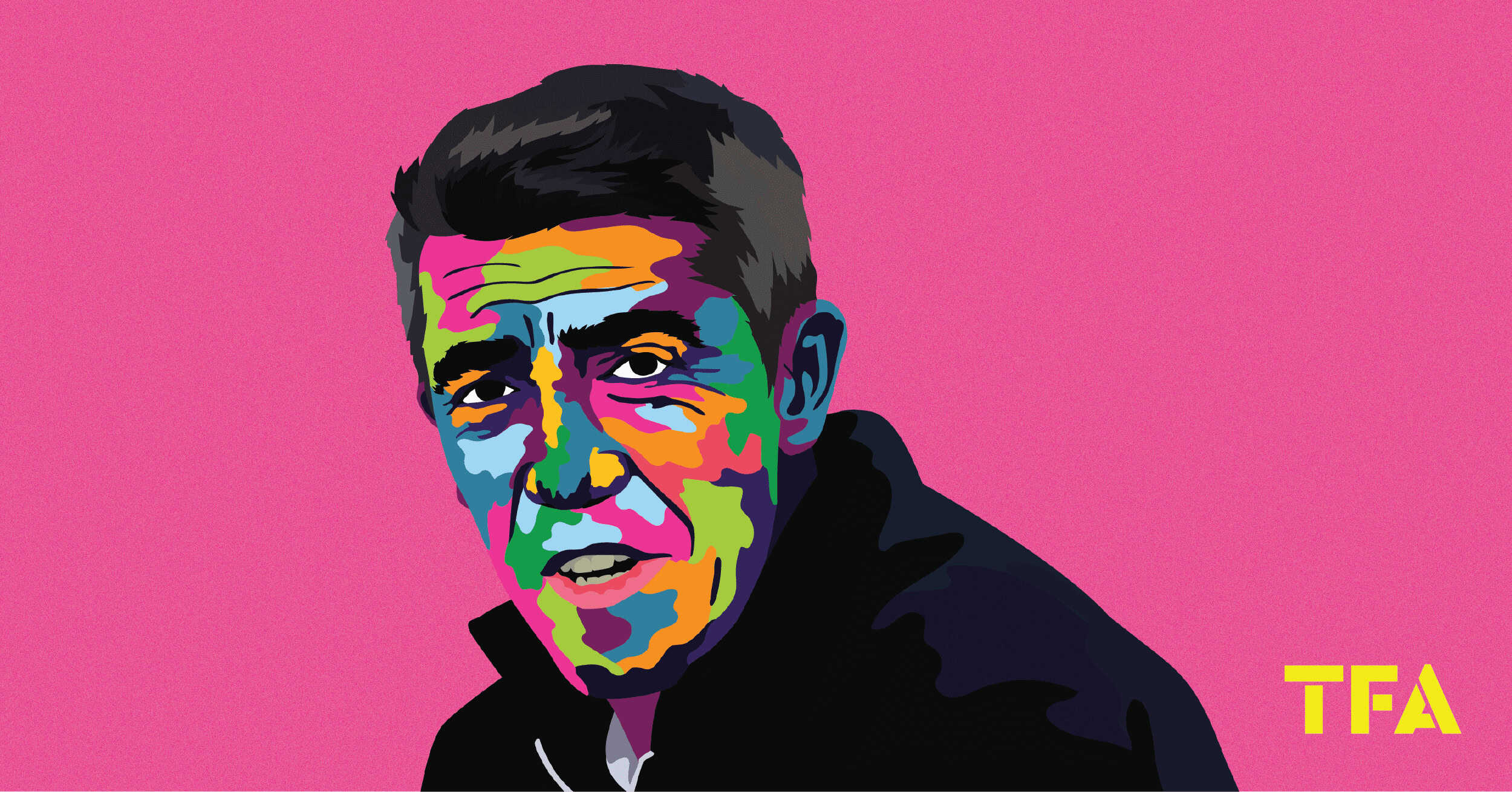



Comments